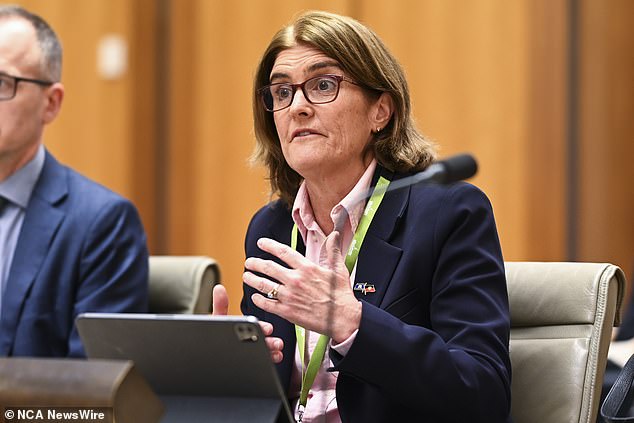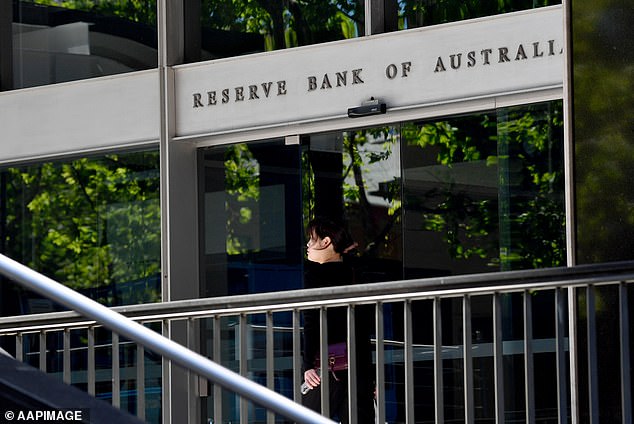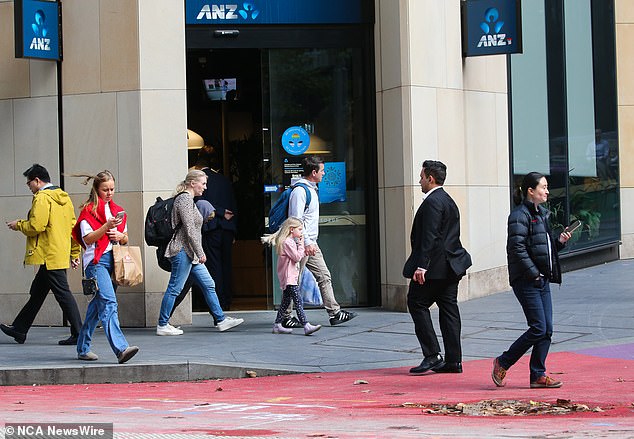Any relief for household borrowers in the form of rate cuts remains a distant prospect and experts warn that interest rates will not fall until 2025.
ANZ Australian economics chief Adam Boyton said firmer-than-expected household consumption, continued labor market resilience and persistent inflation would delay rate cuts until February next year.
‘It’s not that monetary policy is not working. It is,” Boyton wrote in a note to his clients.
‘The economy has clearly slowed down, particularly in private final demand. It is for this reason that we believe that a rate hike remains unlikely.
“However, achieving a proper balance between the level of demand and supply will probably take a little longer than expected.”
ANZ’s head of Australian economics, Adam Boyton, has predicted that interest rates will not fall until early 2025 (pictured, members of the public walking past ANZ Bank in Sydney)

RBA Governor Michele Bullock (pictured) told a Senate estimates hearing last week that a pick-up in inflation could force the bank to raise interest rates once again.
While ANZ economists maintained their projections of two follow-on rate cuts after February, they warned the risks to that projection were skewed to the downside, with cuts worth 50 basis points more likely than four cuts worth 100 basic points.
Investors are more pessimistic about the timing of rate cuts, with money markets already considering a 25 basis point easing in July next year.
Economists and analysts are also watching the release of new US inflation data on Wednesday and the US central bank’s meeting on Thursday (AEST), for clues about the path of rate cuts abroad.
After job growth continued to surprise last month and highlighted the U.S. economy’s continued resilience in the face of stubbornly persistent inflation and high borrowing costs, the Federal Reserve is widely expected to keep rates unchanged.
Fed officials will also present new interest rate forecasts, which are expected to show that a majority of members now foresee two rate cuts by the end of the year, instead of the three cuts that were projected by a narrow majority in a meeting in March.

Any relief for household borrowers in the form of rate cuts remains a distant prospect with experts warning interest rates will not fall until 2025 (file image)
While mortgage stress is increasing amid cost-of-living pressures and high interest rate levels, most household borrowers are meeting their loan repayments, the Australian Council of Financial Regulators said.
The council, which co-ordinates the management of Australia’s financial system and is chaired by RBA Governor Michele Bullock, warned on Tuesday that while most borrowers had managed rising interest rates, the proportion of mortgage borrowers that were in arrears had increased.
“While budget pressures from inflation and interest rates continue to be widely felt, and many households make adjustments to their finances, the majority of borrowers have continued to meet their debt payments,” the council said in a statement.
“Members noted that the proportion of borrowers falling behind on mortgage payments has continued to rise, as have hardship claims, but from a low level.”
From May 2022, the RBA has aggressively raised interest rates 13 times to a 12-year high in a bid to contain inflationary pressures, piling on higher costs for household borrowers.

Economists and analysts are also closely monitoring the release of new US inflation data for clues about the trajectory of rate cuts overseas (pictured, the Reserve Bank of Australia).
Since November, the central bank has kept the cash rate at 4.35 percent as it waits for more evidence that inflation is returning to its target band of 2 to 3 percent.
The council also considered the risks of domestic commercial real estate (CRE) lending in its quarterly review of the financial sector.
“Members noted that these remained contained due to banks’ low exposure, conservative lending practices and the relatively strong financial positions of CRE owners,” the council added.
Responding to the statement, Treasurer Jim Chalmers said the measures coming into effect on July 1 would ease the pressures faced by households.
“People are under pressure and that’s why our budget and economic plan aim to ease cost of living pressures with tax cuts for all taxpayers and energy rebates for every home and a million small businesses.” said Dr. Chalmers.
Data released by the Australian Securities and Investments Commission (ASIC) last month showed the number of distress notices – where a borrower tells their lender they are unable to meet their credit obligations – had increased by 54 per cent. in the last three months of 2024 compared to the corresponding quarter of the previous year.
In May, ASIC urged banks to increase the level of support they provided to distressed borrowers after a review found accessing hardship assistance was too difficult.
While the corporate regulator’s review found that experience differed between lenders, in the worst cases some banks had ignored requests for assistance, in effect “abandoning customers who needed their support”.


